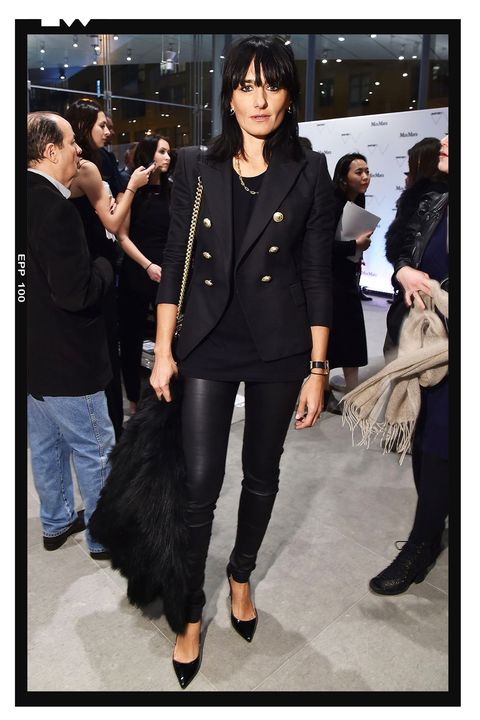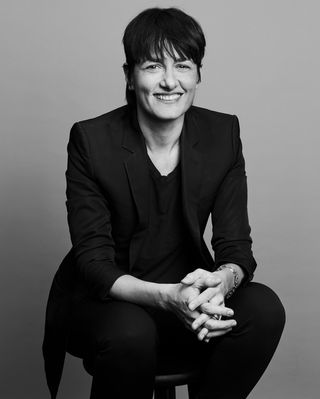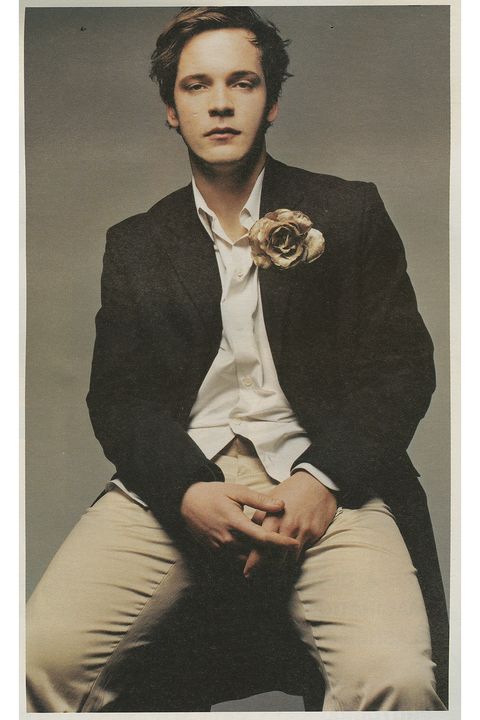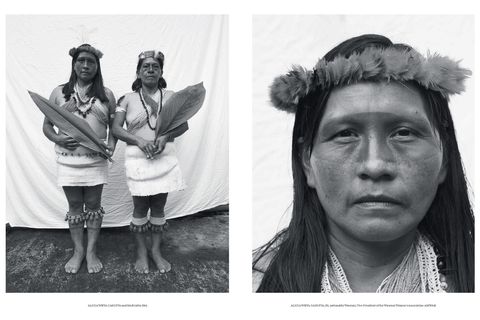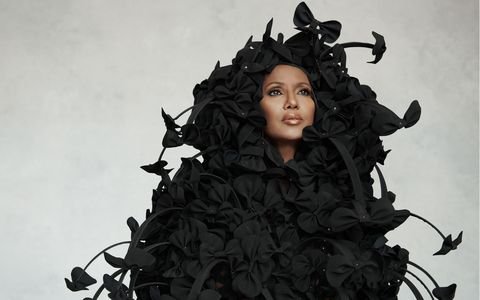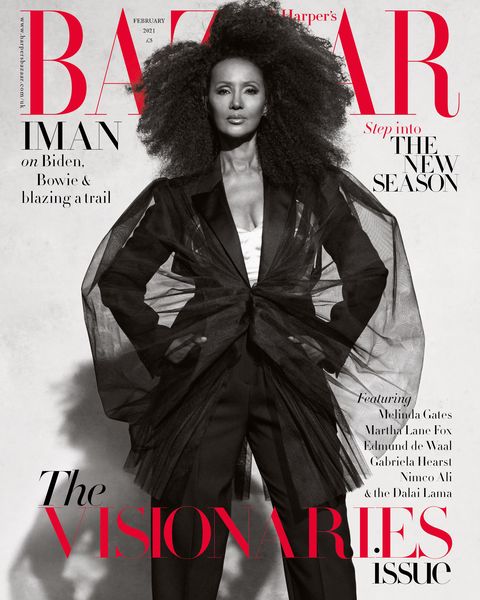Every month, in our new franchise Behind the Lens, we will be getting to know the women behind the beautiful images that fill the magazine’s pages and illustrate our online storytelling at Harper’s Bazaar. From celebrity cover stories to fairy-tale fashion editorials, every image is lovingly captured by one of our talented pool of visionary photographers, without whom the brand wouldn’t be what it is today.
This month we’re turning the spotlight on photographer Paola Kudacki, recently responsible for our February 2021 cover starring the inimitable Iman.
How did you get into photography?
“My first dream was to be a ballet dancer. I was born in a small town called General Rodriguez in Buenos Aires, Argentina. My father was an artist, so I grew up surrounded by paintings and art books, with paint in my hands. He was a bohemian so that was very inspiring and crazy at times.
“When I was five, he took me to the capital of Buenos Aires as he was going to buy oils for his paintings. The shop was in an area near the Teatro Colon, a renowned theatre, which had Ravel’s Carmen by the Bolshoi Ballet with the first ballerina Maya Plisetskaya on that night. The way that he described it was so exciting and I really wanted to go. My father was not wearing a suit so he could not enter, so he bought me a ticket and sent me in by myself.
“Watching the ballet was so inspiring and exciting that I quickly became obsessed with it. I wanted to be a ballerina. That was my first dream and still inspires me to this day. I studied ballet for many years, but when I broke my leg during a long-jump, that dream was broken by the thought of never being able to become a first ballerina.
“So, I worked really hard to recuperate and continued to study and to paint. I was always observing light and shadows. During high school, I was teaching aerobics to get some money to pay for my school and I met a woman that had an advertising agency. She asked me if I would like to attend a casting for a Diet Coke commercial. So I did and I got the job. After that first job, she introduced me to a photographer and I started to meet a few other photographers that took pictures of me for my portfolio. I began to do some modelling jobs and that allowed me to pay for my studies.
“One of the photographers I met was Esteban Calcagno. We did some pictures and then he asked me if I would help him with styling and maybe we could create some images together. This turned into a fun, creative relationship where I was doing hair, make-up and styling, and we were working on the ideas together. After about a year of this collaboration, he moved away to develop his career abroad. It was, in a way, very disappointing because I was really enjoying working with him and making images.
“So, I spoke to my friend, Laura Peirano, who was studying photography, and she said, ‘Why don’t you take the pictures yourself?’ I was shocked that she just said that, and I had never even considered it. She introduced me to the director of the photography school, an incredible, crazy and inspiring Italian teacher named Aldo Bressi. He taught me the basics of photography: the zone system, how to develop and print my own images, and shared his admiration for the models and the photography of the nineties. I told him that I could not wait two years to finish the course and I asked him if he could teach me one-to-one. Of course, I could not afford the private lessons, so I offered to model for the school and to talk to the students from my knowledge about graphic design and what I learned about composition etc. Fortunately for me, he agreed.
“Very quickly I realised that I loved photography. I spent many hours in the darkroom trying out different techniques and working on my own prints. I learnt very fast and became infatuated with it. After two months, I said to myself, ‘This is it! Now, how do I get to New York?’
“Coming to New York was both fun and tough at times, but I was super excited to be here and to live the new adventure. Nothing felt impossible. After a few trips back and forth, I finally got signed to an agency.
“I had one camera and one strobe light. I was doing the styling, hair and make-up, the same as I had done back home. I was always shooting on film, because digital didn’t exist back then, and printing my own images. I photographed a lot of inexperienced young models that were coming to town for the summer. That was the best school. Learning while doing it. That is how all started it.”
What was your first photography job or commission?
“My first ever job as a photographer was in Argentina. It was a campaign for a clothing brand. I was the creative, the photographer, the stylist, I did hair and make-up, and I even built the set myself.”
What was the shoot that changed your career?
“While in New York, I met a woman named Sharon Mendelow, who became a really good friend and we’ve been friends now for many years. She was at the time replacing the photo editor at Interview magazine, so she asked me to stop by to show my portfolio.
“I went to the magazine and was in awe of Andy Warhol’s art installations in the lobby. I was so excited about going in for an appointment with such an iconic magazine. After meeting her and showing my portfolio she said: ‘I will try to suggest you for something.’ Sharon said she would walk me out and when we left her office we bumped into Ingrid Sischy in the hallway. Ingrid was a total icon and the editor-in-chief at Interview for many years- that was my American dream right there. Sharon introduced me very quickly. Ingrid invited me to her office, we had a chat, she looked at my portfolio and gave me my first assignment, on the spot. The shoot was a portrait of actor Peter Sarsgaard. I shot it at my place, an industrial loft that I shared with a roommate in Brooklyn. Peter was already a big star and I was very honoured to photograph him, but I was not really thinking about the magnitude of the shoot. I shot him in a few different looks to have some options, even though I was only supposed to bring back one portrait. One of the looks was a jacket. When I started to take that portrait, I thought something was missing. I turned around and I asked his publicist if I could use the brooch she was wearing. I placed the brooch on Peter’s jacket and that made the picture. Many years later I met her again and she remembered that moment as something really special.
“When I sent my selects, the magazine loved them and they made it into an eight-page feature. This shoot really changed me; it made me feel like a professional photographer. That’s when I realised I was living my dream.”
What’s the best piece of career advice you’ve ever been given?
“When I first came to New York, I was looking for a job as a photographer, in a studio, exploring all the options. I was asked by someone in one of the studios to present a resume alongside my portfolio. I didn’t have a resume or even a computer to write one.
“My landlord mentioned that I could probably ask for a favour at the architect’s studio next door to the building where I was living at the time. While using their computer, one of the architects asked me what I did. I told him I was a photographer and he told me his wife was one as well. ‘Does she need an assistant?’ I remember asking. ‘What’s your dream?’ he said. ‘I want to shoot for Vogue,’ I replied. He then gave me the best advice, which I’ve never forgotten: ‘My wife is a wedding photographer. You don’t need to work for her. You know what you want so just follow your dream. Go out there and take your own pictures.’”
Which person or location you’ve shot stands out the most for you over your career, and why?
“I’ve photographed many important and famous actors, musicians and models throughout my career, but I’d say the portfolio I did in the Amazons – because one of my concerns is climate change and how we affect the environment and our planet.
“I contacted an incredible indigenous woman through Instagram, Nina Gualinga, who is a spokesperson for the woman in the Amazon. After a few texts and phone calls, we organised a trip. I travelled to Ecuador with my assistant to meet and photograph an amazing group of women leaders; true warriors that are native to the Amazon, who fight to preserve their land from the oil excavations that are contaminating the land and destroying the ecosystem. They are fighting for their families as well as ‘the integrity of the lung of the planet’, as they described it.
“They travelled from the deep forest in the Amazon to meet me in Puyo. I had the pleasure of photographing them and interviewing them and I got to learn about their way of living and their concerns, and the conflicts with the oil companies and within the communities.
“It was such an incredible experience. They are such an inspiring group of women and it was an honour to be welcomed in their land.”
What was your favourite shot from your recent Harper’s Bazaar cover shoot with Iman?
“Iman is an icon. The experience of meeting her again and photographing her was actually my favourite thing.
“It’s difficult to choose one image. She is super collaborative; she knows what she likes and what will work on her. She also trusts me, which is the most important thing between talent and photographer. In one of the images, Iman was wearing an incredible dress by Noir Kei Ninomiya – a piece of art. We can only see Iman’s face looking straight to the camera – almost vulnerable, pure, simple. I love how she is crowded by the flowers of the black dress but she still stands out emerging from the garment.”
Who or what do you find interesting subjects to photograph?
“I enjoy photographing humans. I believe that every subject is beautiful and curiosity will always allow me to discover their story. For me, one of the most interesting things about photography is the connection with the talent and the challenge of creating a good image – sometimes with somebody that doesn’t necessarily want to be photographed or doesn’t have any experience in front of the camera.
What makes a good photo?
“The photo that I’m most interested in capturing is the one that conveys a moment of vulnerability: when the subject is open and their deep emotions emerge through their eyes. Sometimes, a very deep connection happens in a single moment of total trust during the photographic session, and that is the most magical and exciting part of being a photographer.”
In need of some at-home inspiration? Sign up to our free weekly newsletter for skincare and self-care, the latest cultural hits to read and download, and the little luxuries that make staying in so much more satisfying.
SIGN UP
Plus, sign up here to get Harper’s Bazaar magazine delivered straight to your door.
SIGN UP


